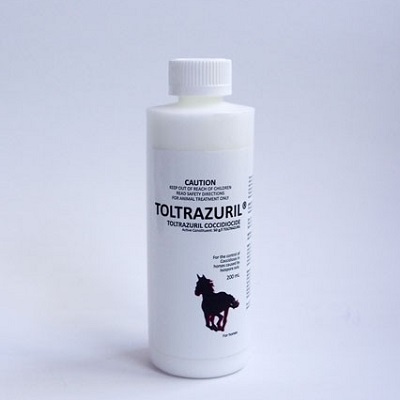Toltrazuril Chemische Eigenschaften,Einsatz,Produktion Methoden
R-S?tze Betriebsanweisung:
R50/53:Sehr giftig für Wasserorganismen, kann in Gew?ssern l?ngerfristig sch?dliche Wirkungen haben.
R36/37/38:Reizt die Augen, die Atmungsorgane und die Haut.
S-S?tze Betriebsanweisung:
S60:Dieses Produkt und sein Beh?lter sind als gef?hrlicher Abfall zu entsorgen.
S61:Freisetzung in die Umwelt vermeiden. Besondere Anweisungen einholen/Sicherheitsdatenblatt zu Rate ziehen.
S37/39:Bei der Arbeit geeignete Schutzhandschuhe und Schutzbrille/Gesichtsschutz tragen.
S26:Bei Berührung mit den Augen sofort gründlich mit Wasser abspülen und Arzt konsultieren.
Beschreibung
Toltrazuril (Baycox®,Procox®) is a triazinon drug thathas broad-spectrum anticoccidial and antiprotozoalactivity. It is not commercially available in the UnitedStates, but it is available in other countries. It is activeagainst both asexual and sexual stages of coccidia byinhibiting nuclear division of schizonts and microga-monts and the wall-forming bodies of macrogamonts. Itmay also be useful in the treatment of neonatal porcinecoccidiosis, EPM, and canine hepatozoonosis.

Toltrazuril and its major metabolite ponazuril (toltrazuril sulfone, Marquis) are triazine-based antiprotozoal drugs that have specific activity against apicomplexan coccidial infections. Toltrazuril is not available within the United States.
Physikalische Eigenschaften
Toltrazuril is white or off-white color crystalline powder, and odorless is molten in the methanol part omitted at ethyl acetate, dichloromethane, Polyethylene Glycol, α-adjoin in the organic solvents such as pyrrolidone, propylene glycol and dissolve, and is insoluble in water.
Verwenden
Toltrazuril is an antiprotozoal agent that is widely used to prevent
coccidia parasite infection in veterinary applications. The
effectiveness of treatment appears to depend on the coccidian species,
development stage of the parasite, and level of infection.
Verwenden
Labelled analog of a triazinetrione anticoccidial. Coccidiostat. Toltrazuril is found to be highly effective against coccidia and is used in controlling coccidiosis. It is acting against all intracellular development stages of coccidia of the merogony (asexual multiplication) and gamogony (sexual phase). All stages are destroyed, thus the mode of action is coccidiocidal.
Physiological effects
Toltrazuril is suitable for both therapy and metaphylaxis, by damaging the intracellular developmental stages of Coccidia. Findings from studies suggest it interferes with the division of the nucleus and the activity of mitochondria, which is responsible for respiratory metabolism in the parasite.
Environmental Fate
The metabolite of toltrazuril, toltrazuril sulfone (ponazuril) is a persistent (half-life >1 year) and mobile compound and has adverse effects on both the growth and emergence of plants. Given the persistent properties of ponazuril repeated spreading of manure from treated animals may lead to an accumulation in the soil and consequently a risk to plants. The accumulation of ponazuril in soil together with its mobility also leads to a risk of leaching to groundwater.
Toltrazuril Upstream-Materialien And Downstream Produkte
Upstream-Materialien
Downstream Produkte

